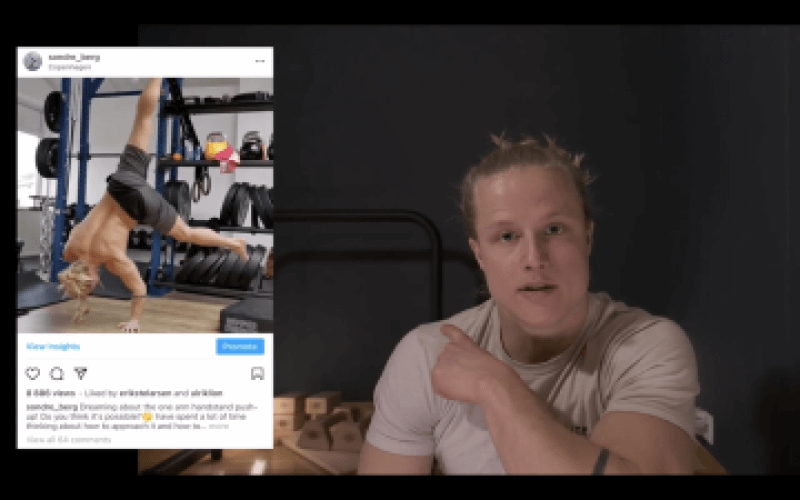10 Tips on Managing Injuries For calisthenics & handstands
Injuries…sigh :(. I hope you never have to read this article and stay injury free, but if that isn’t you, let’s go over what you can do about it.
If you are here because of handstand wrist pain, elbow pain from planche, or a painful shoulder from pull-ups - it doesn’t matter! There are some common denominators that can help you get through your injury and in this article I will go through some techniques and philosophies to help you on the road to managing your injuries.
Managing you injuries is key to getting far in calisthenics, handstands and other movement training disciplines. Be it wrist injuries from handstands, or elbow pain from planche training, there’s always something you can do about it.
* First off, I am not a medical profession and all the following tips are based on my experience as a coach and athlete. Seek professional medical help to be sure you are doing the right thing.
A lot of people ask me, “how do you stay injury free?”. In fact.. I don’t stay injury free. But the difference, in my opinion, between people who make it far in their sport and those who don’t, is how well those people manage their injuries.
In this article, I’m going to give you 10 helpful tips on how to deal with injuries. Of course, preventing injury in the first place is ideal. But, when that is a foregone conclusion, we must learn to manage our injury.
You might be surprised at what can come as a result of being injured. Personally, being injured has actually enabled me to learn new moves, such as the inverted muscle up; it has inspired me to focus on areas that I’d previously neglected; and it has allowed me to work on new things, such as the One Armed Handstand Push Up (still a work in progress.) The saying “when one door closes, another one opens” comes to mind in that regard.
My road to the One-Armed Handstand Push Up was an idea born from injury.
The 10 tips I’m going to share with you in this article are all about injury management. Injury management is about three things, and those tips will be divided into these categories:
Injury prevention: preventing injury through mobility and strength drills
Treating injury: introducing various exercises
Training with and around injury and staying motivated
Injury prevention for calisthenics and handstands:
1. Injuries can happen from chronic overuse, or can come as a result of trauma. This is where tip number 1 comes into play, and that is:
know your limits and don’t do stupid shit!
For example, if you only recently learned how to do a free handstand, it might not be wise to try one on the high canes and hope for the best.
But hey! You might look at a lot of the stuff I do and think, that’s pretty stupid. For example ,this handstand drop. But I’d been preparing for this particular move for years, training strength, technique, and my wrists to be able to perform the move. I also did lots of behind the scenes training before actually going for the full handstand drop, using mattresses, higher wooden planks, and so on. It would have been very stupid for me to go straight to the handstand drop without having broken the movement down into progressive steps, and I probably would have gotten myself injured trying it. Be prudent in your training :)
Doing this handstand drop right after learning how handstand would be stupid, but it was the culmination of years of training.
2. Listen to your body.
No one knows it better than you. Overuse injuries are usually a sign of doing too much, too soon. But it can also be a sign that you are being too repetitive with your movement patterns.
3. Prepare your muscles, joints, and ligaments by increasing and strengthening your ROM.
In my experience, it is hugely beneficial to both a)increase the ROM that we are working in, as well as strengthening our ligaments and muscles in the upper limits of our ROM. You can achieve this by doing the relevant mobility and strengthening exercises for the moves that you are training.
Increase your ROM and actually try to improve your mobility.
4. Avoid being too repetitive in your movement patterns by switching up your exercises, grips, and shoulder position.
For example, with pull-ups, you can alternate between using a pronated and a supinated grip, and you can change how narrow/wide your grip is as well. You could also switch between using rings and bars. For handstands, you can switch up your grip by alternating between blocks, parallettes/ p bars, and using the floor.
Remember to switch up your grip, whatever the movement your training may be.
Treating Calisthenics related Injuries
When it comes to treating injuries, there are certain things that can be done. Usually, it has to do with increasing blood flow to the relevant area, as well as rebuilding strength in the injured tendon or muscle. One thing to note is that there is a huge difference in the healing processes and time required for healing between muscles, tendons, and ligaments. Because tendons have better blood supply than ligaments, tendon injuries tend to heal faster than ligament injuries of comparable severity.
The exercise you use to treat your injury will hugely depend on what kind of injury you have, so I will not go too much into detail about all the different exercises for all the different injuries. The key thing to remember here is:
5. Doing nothing is often the worst thing you can do.
Believe it or not! Especially for injuries that turn chronic. The research is pretty clear on this - just resting until it stops hurting and then starting to train again, will in most cases cause the pain to return eventually. Injury is our body’s way of telling us that we need to do something differently.
Training with Injuries in wrists and shoulders:
6. Don’t make it all about the injury.
Don’t think of your ability to train only in terms of the area that you’re injured. A lot of people get stuck doing only the exercises their physiotherapist has given them over and over and over again. However, in most cases, you can actually continue training when you have an injury. There are a number of ways you can do this.
7. Adjust your exercise intensity to stay within an acceptable level of pain.
In this case, the idea is that you don’t even need to stop doing whatever it is that provokes pain. Rather, you only need to adjust the intensity of the exercise so that the pain is at a minimal level. For example, if doing unassisted pull ups bothers your shoulder, maybe cable pull downs would be a good idea. I personally was dealing with Medial Epicondylitis for a while and was only able to do supinated grip pull ups during that time. At another time when I was dealing with a wrist injury, I continued to train my handstands with closed fists, so as not to provoke any wrist pain.
I learned to do HSPUs on my fist during a period where my thumb was injured. If you’re creative, injury can lead to cool new movements!
8. All of the above being said: there is often a way around your injury.
Spend some time playing around with different variations of movements that you want to continue training while injured. Listen to your body and figure out for yourself which movements can still be performed while being injured.
9. If there is no way around the pain, create new goals to help you stay motivated while injured.
If, for example, you experience severe pain in your shoulder in all the movements that you try, and aren’t really able to do any upper body exercises without experiencing too much pain, perhaps you could create a lower body-oriented goal for yourself. For example, you could try to improve your lower body flexibility, or your vertical jump.
10. Make an injury game plan.
→ What can you do to hurry up the healing process?
→ What can you do without the pain being too severe?
→ Are there other things I hadn’t thought of before that I can introduce into my training?
To finish up, I’ll share one personal example of an injury I got and how I dealt with it. Awhile ago I really hurt my MCP joint in my thumb, and so I wasn’t able to do handstands the regular way. Handstands make up a huge part of the movements, combos, and sequences that I do, and with the injury I wasn’t able to do them anymore. But then I got to thinking… is there a way that I can do a handstand without using my thumb?! So, for three months, I worked on doing different kinds of handstand push ups on my fists, so that my thumb injury wasn’t inflamed. So, my actual handstands inevitably suffered a bit during this period, but I was able to train my pushing strength as usual.
A little story about how my road to the One Armed Handstand Push Up got started.
To summarize we’ll quickly go over all the steps we went over… how to manage calisthenics injuries:
know your limits
listen to your body
Prepare your muscles, joints, and ligaments by increasing and strengthening your ROM.
Avoid being too repetitive in your movement patterns by switching up your exercises, grips, and shoulder position
Doing nothing is often the worst thing you can do.
Don’t make it all about the injury.
Adjust your exercise intensity to stay within an acceptable level of pain.
All of the above being said: there is often a way around your injury.
If there is no way around the pain, create new goals to help you stay motivated while injured.
Make an injury game plan.
My road and continuing efforts in working towards a one armed handstand push up is another example of something that came as a result of being injured.
So! I suppose the essence of this article is: if you’re injured, don’t worry too much. There is still lots that you can do to minimize any loss of progress, and you may even find yourself working on something new and exciting that reignites the fire within you and gets you training even harder than you were before.
Share Post!
Leave a comment :)








